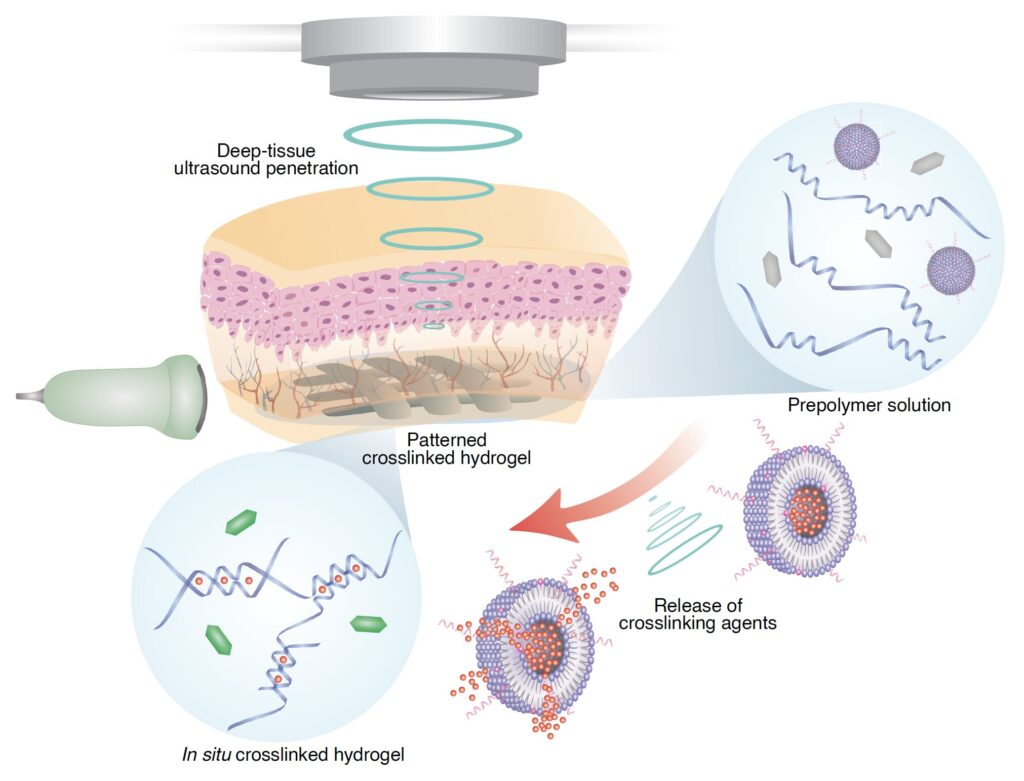Imagine that doctors could precisely print miniature capsules capable of delivering cells needed for tissue repair exactly where they are needed inside a beating heart.
A team of scientists led by Caltech has taken a significant step toward that ultimate goal, having developed a method for 3D-printing polymers at specific locations deep within living animals. The technique relies on sound for localization and has already been used to print polymer capsules for selective drug delivery as well as glue-like polymers to seal internal wounds.
Previously, scientists have used infrared light to trigger polymerization, the linking of the basic units, or monomers, of polymers within living animals.
“But infrared penetration is very limited. It only reaches right below the skin,” says Wei Gao, professor of medical engineering at Caltech and a Heritage Medical Research Institute Investigator. “Our new technique reaches the deep tissue and can print a variety of materials for a broad range of applications, all while maintaining excellent biocompatibility.”
Gao and his colleagues report their new in vivo 3D-printing technique in the journal Science.
Along with bioadhesive gels and polymers for drug and cell delivery, the paper also describes the use of the technique for printing bioelectric hydrogels, which are polymers with embedded conductive materials for use in the internal monitoring of physiological vital signs, as in electrocardiograms (ECGs). The lead author of the study is Elham Davoodi, an assistant professor of mechanical engineering at the University of Utah, who completed the work while a postdoctoral scholar at Caltech.
The origin of a novel idea
Wanting to figure out a way to realize deep tissue in vivo printing, Gao and his colleagues turned to ultrasound, a platform that is widely used in biomedicine for deep tissue penetration. But they needed a way to trigger crosslinking (binding of monomers) at a specific location and only when desired.
They came up with a novel approach: Combine ultrasound with low-temperature–sensitive liposomes. Such liposomes, spherical cell-like vesicles with protective fat layers, are often used for drug delivery. In the new work, the scientists loaded the liposomes with a crosslinking agent and embedded them in a polymer solution containing the monomers of the polymer they wanted to print, an imaging contrast agent that would reveal when the crosslinking had occurred, and the cargo they hoped to deliver—a therapeutic drug, for example.
Additional components could be included, such as cells and conductive materials like carbon nanotubes or silver. The composite bioink was then injected directly into the body.
Raise the temperature just a touch to trigger printing
The liposome particles are low-temperature sensitive, which means that by using focused ultrasound to raise the temperature of a small targeted region by about 5 degrees Celsius, the scientists can trigger the release of their payload and initiate the printing of polymers.
“Increasing the temperature by a few degrees Celsius is enough for the liposome particles to release our crosslinking agents,” says Gao. “Where the agents are released, that’s where localized polymerization or printing will happen.”
The team uses gas vesicles derived from bacteria as an imaging contrast agent. The vesicles, air-filled capsules of protein, show up strongly in ultrasound imaging and are sensitive to chemical changes that take place when the liquid monomer solution crosslinks to form a gel network. The vesicles actually change contrast, detected by ultrasound imaging, when the transformation takes place, allowing scientists to easily identify when and precisely where polymerization crosslinking has occurred, enabling them to customize the patterns printed in live animals.
The team calls the new technique the deep tissue in vivo sound printing (DISP) platform.
When the team used the DISP platform to print polymers loaded with doxorubicin, a chemotherapeutic drug, near a bladder tumor in mice, they found substantially more tumor cell death for several days as compared to animals that received the drug through direct injection of drug solutions.
“We have already shown in a small animal that we can print drug-loaded hydrogels for tumor treatment,” Gao says. “Our next stage is to try to print in a larger animal model, and hopefully, in the near future, we can evaluate this in humans.”
The team also believes that machine learning can enhance the DISP platform’s ability to precisely locate and apply focused ultrasound.
“In the future, with the help of AI, we would like to be able to autonomously trigger high-precision printing within a moving organ such as a beating heart,” Gao says.


